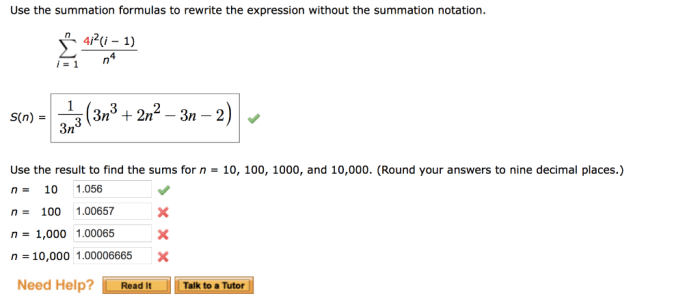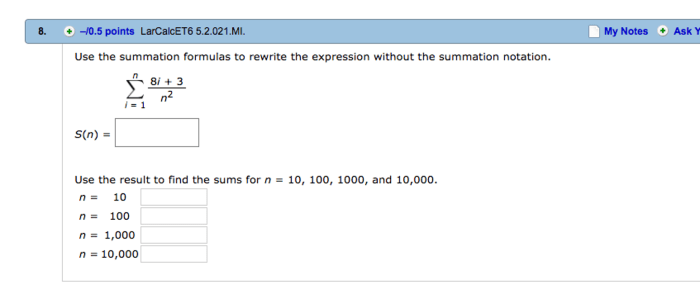Use the summation notation to rewrite the following expression is a powerful mathematical tool that allows us to represent complex expressions in a concise and elegant way. This notation is widely used in various fields, including calculus, statistics, and physics, making it an essential concept for anyone seeking to delve deeper into the world of mathematics and its applications.
In this comprehensive guide, we will explore the concept of summation notation, its mathematical representation, and its applications. We will also provide a table of common summation formulae and discuss the properties of summation, such as associativity, commutativity, and distributivity.
Summation Notation Overview

Summation notation is a mathematical shorthand used to represent the sum of a series of terms. It is commonly used in mathematics, statistics, and other scientific fields to simplify and condense expressions.
The mathematical representation of summation notation is the Greek letter sigma (Σ), which is placed over a variable that represents the terms being summed. The variable typically represents the index of the term in the series.
Applying Summation Notation
To rewrite an expression using summation notation, follow these steps:
- Identify the terms being summed.
- Determine the variable that represents the index of the terms.
- Write the summation notation as Σ variableupper limitlower limitterm.
For example, the expression 1 + 2 + 3 + 4 + 5 can be rewritten using summation notation as Σ i=15i.
Table of Summation Formulae

| Formula | Description | Example |
|---|---|---|
| Σi=1n i | Sum of the first n natural numbers | Σi=15 i = 1 + 2 + 3 + 4 + 5 = 15 |
| Σi=1n i2 | Sum of the squares of the first n natural numbers | Σi=15 i2 = 12 + 22 + 32 + 42 + 52 = 55 |
Σi=1n (2i
|
Sum of the first n odd numbers | Σi=15(2i
|
Properties of Summation: Use The Summation Notation To Rewrite The Following Expression
Summation has several properties that are useful for simplifying and manipulating expressions. These properties include:
- Associativity:Σ i=1n(Σ j=1ma ij) = Σ j=1m(Σ i=1na ij)
- Commutativity:Σ i=1n(a i+ b i) = Σ i=1na i+ Σ i=1nb i
- Distributivity:Σ i=1n(c – a i) = c – Σ i=1na i
Applications of Summation Notation
Summation notation is widely used in various mathematical and scientific fields, including:
- Calculus:To calculate integrals and derivatives
- Statistics:To calculate means, variances, and other statistical measures
- Physics:To calculate forces, energies, and other physical quantities
Variations of Summation Notation

There are several variations of summation notation, including:
- Sigma notation:The most common form of summation notation, using the Greek letter sigma (Σ).
- Summation over sets:Uses set notation to specify the range of values over which the summation is performed.
Frequently Asked Questions
What is summation notation?
Summation notation is a mathematical notation used to represent the sum of a series of terms. It is typically written using the Greek letter sigma (Σ), followed by the index of summation (i), the lower and upper bounds of summation (a and b), and the expression to be summed (x).
How do I use summation notation?
To use summation notation, you need to specify the index of summation, the lower and upper bounds of summation, and the expression to be summed. For example, the following expression represents the sum of the numbers from 1 to 10:
“`Σi=1^10 i“`
What are the properties of summation?
Summation has several properties, including associativity, commutativity, and distributivity. These properties allow us to manipulate sums in various ways without changing their value.